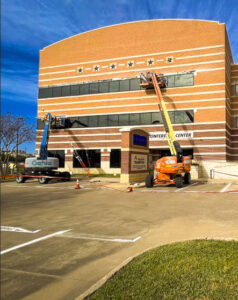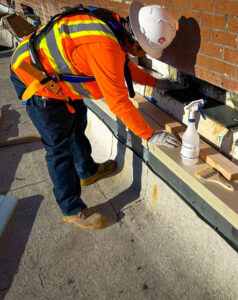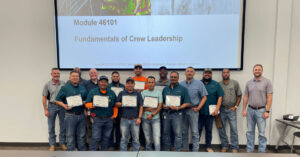Chamberlin Takes Training to a Higher Level
 Chamberlin Roofing and Waterproofing is a well-established construction company concentrating on new and remedial projects. The company is based in Houston, Texas, with satellite offices in Austin, San Antonio, Dallas/Ft. Worth and Oklahoma City. They have a broad reach across the South-Central Gulf states, doing business in Texas, Oklahoma, Louisiana, Arkansas and New Mexico.
Chamberlin Roofing and Waterproofing is a well-established construction company concentrating on new and remedial projects. The company is based in Houston, Texas, with satellite offices in Austin, San Antonio, Dallas/Ft. Worth and Oklahoma City. They have a broad reach across the South-Central Gulf states, doing business in Texas, Oklahoma, Louisiana, Arkansas and New Mexico.
Founded in 1897 in Detroit, Michigan, as Chamberlin Weatherstrip Company of America, the business has witnessed firsthand countless transformations, from a name change to advancements in the construction industry. More than 800 employees work for Chamberlin today, with its singular focus to “keep water out of buildings.” To meet this goal, Chamberlin has created and relies on a well-trained workforce and a well-thought-out training program.
The People
Lyle Coston is the Vice President and General Manager of the Houston office and has been with Chamberlin since 2000. Before Chamberlin, Coston began his construction career in the field in 1997 as a waterproofer and caulker at another company in Austin. His career path is like most of his co-workers at Chamberlin: he worked his way up. The company develops its talent from within.
When Coston began working with Chamberlin, he was unsure of where he wanted to take his career. Coston said the CEO emphasized co-workers would recognize his talent and would help develop his skills bringing out the best in him.
“I asked our CEO ‘What are the ways that I can move up within the company?’” Coston explained. “He gave me insight and advice, ‘Your peers promote you. They’re going to help promote you.’”
The CEO then added another piece of advice: Help develop others.
“Throughout my career, I’ve tried to always take the time to answer questions and have an open-door policy,” Coston said.
It’s a philosophy that permeates the Chamberlin culture — they encourage and promote growth from within.
“We build our teams [internally] and put them on a career path,” Coston said. “We’ve created a program where our employees can grow. We encourage and empower the workforce to grow through education. The training empowers employees to control their destiny.”
The Evolution of a Training Program – From Chamberlin ‘U’ to NCCER
 The driving force behind the team approach is Chamberlin University (Chamberlin ‘U’) — a training curriculum that has evolved and has become more formalized since it was conceived in 2006.
The driving force behind the team approach is Chamberlin University (Chamberlin ‘U’) — a training curriculum that has evolved and has become more formalized since it was conceived in 2006.
Chamberlin ‘U’ is part of a broader company strategy to prepare its workforce through training and education for an ever-changing industry. Chamberlin ‘U’ has graduated hundreds of craft workers and superintendents since its inception and invested thousands of hours in training and education.
Over the years, the company adjusted and modified the framework of courses in Chamberlin ‘U’, but a more formal program wasn’t instituted until 2019 when there was a push for buy-in from Operations Management for more structured training.
“Once we got buy-in,” Coston said, “The program took off!”
It was in 2019 that Chamberlin ‘U’ started to incorporate NCCER training programs.
Operations Management
Shane Hubbard is Senior Operations Manager in the Houston market and oversees the Waterproofing and Roofing Contractors’ Divisions. Hubbard has been with Chamberlin for 34 years and, like Coston, he too started in the field. Today he works with Coston and closely with Chamberlin’s Training and Development team.
Hubbard described the integration of NCCER into Chamberlin’s training curriculum and its importance.
“We’ve placed more of an emphasis over the last couple years on NCCER because of how formal they are and how developed the curriculum is versus what we had with Chamberlin ‘U’,” said Hubbard. “We wanted to complement Chamberlin ‘U’ with training that was available through NCCER certifications.”
Chamberlin has been using NCCER modules like Thermoplastic Polyolefin (TPO) and Modified Bitumen, Roofing curriculum Level 1 and Level 2, along with safety, soft skill and technical skill classes that allow work crews to deliver quality and cost-effective projects that are completed safely and productively.
Leadership Training
 Hubbard said that Chamberlin also has an emphasis on training foremen and frontline positions, and that integrating NCCER leadership courses like Mentoring for Craft Professionals and Fundamentals of Crew Leadership has benefitted leadership development outcomes.
Hubbard said that Chamberlin also has an emphasis on training foremen and frontline positions, and that integrating NCCER leadership courses like Mentoring for Craft Professionals and Fundamentals of Crew Leadership has benefitted leadership development outcomes.
“Since implementing the NCCER leadership courses, what I’ve noticed is the guys that we put through the Fundamentals of Crew Leadership, once they’ve graduated from that class, their whole outlook on leadership and dealing with people, different personalities, and conflict has greatly improved,” he said. “There’s an extremely noticeable improvement after going through these classes.”
The results of the classes have been so successful that Chamberlin now requires foremen and superintendents to take the Mentoring for Craft Professionals as well as Fundamentals of Crew Leadership classes before graduating from Chamberlin ‘U’.
Training Team – Training Works
Representing the training team is Bradley Rowan, Director of Training and Development. Rowan is Chamberlin ‘U’’s exclusive NCCER-certification administrator. He started with Chamberlin in 2017 in the field, like Coston and Hubbard, then transitioned to Quality Assurance/Quality Check before landing in the training role.
As the exclusive NCCER trainer, Rowan oversees leadership classes. He explained that the NCCER curriculum has made his job easier.
“Before we had NCCER, we created everything in-house,” he said. “We had PowerPoints, we had pictures, but it was very, very time consuming. It took a lot of time to develop everything from the ground up. NCCER has done a wonderful job standardizing everything, and it’s nationally recognized.”
Rowan spoke of a recent conversation with a field operations manager who originally had concerns about the cost and time commitment for training but has had a shift in perspective after seeing the results.
“He would always ask ‘Who’s going to pay for it? How’s it going to be funded? We’re too busy. We don’t have time for training,’” Rowan recalled.
“He’s changed a whole 180 degrees. He’s like, ‘You know what? Because of the training, we have a better skilled workforce. I’m able to do more than I was before and we’re much leaner. We’re much more profitable. Our callback numbers are down and it’s a direct result of training.’”
“We are getting more work performed because of training,” Rowan said. “We’ve taken on more work and we’re doing it with fewer people because of a better trained workforce.”
To learn more about how NCCER can help contractors develop their workforce, click here.

